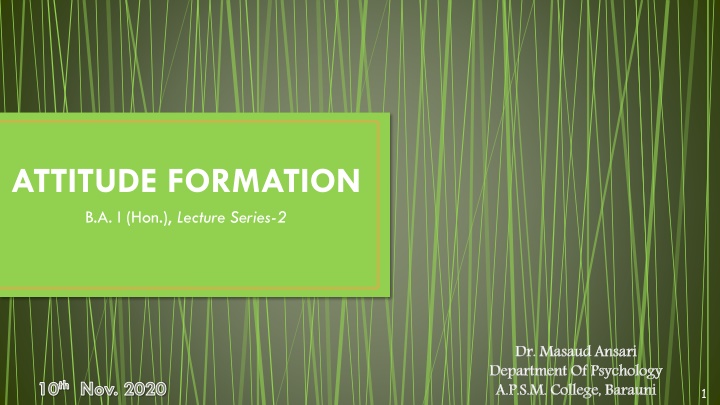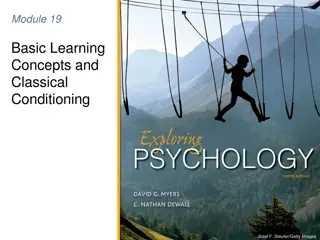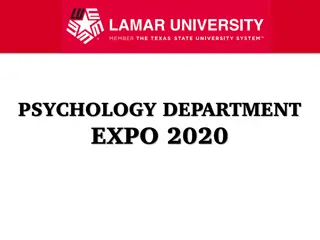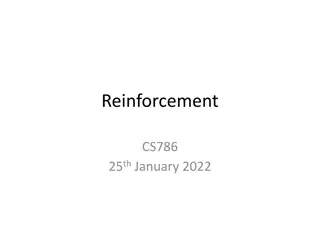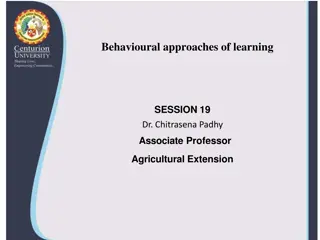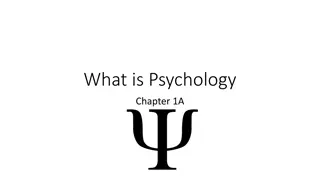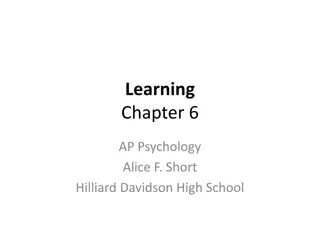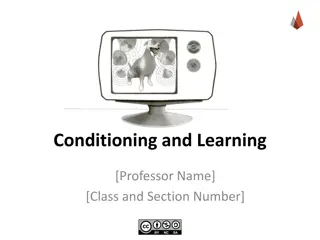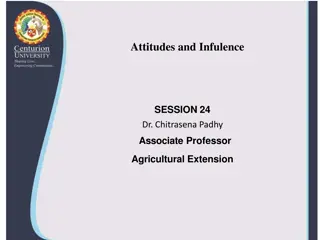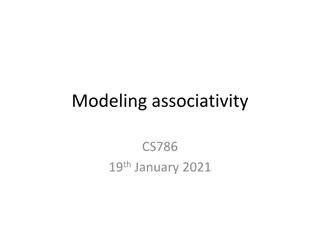Attitude Formation and Classical Conditioning in Psychology Lecture Series
How attitudes develop through social learning and classical conditioning in psychology. Explore the influence of stimuli and association on attitude formation, including direct and indirect pathways. Consider the impact of experiences, interactions, and media exposure on attitude formation and change over time.
Download Presentation

Please find below an Image/Link to download the presentation.
The content on the website is provided AS IS for your information and personal use only. It may not be sold, licensed, or shared on other websites without obtaining consent from the author.If you encounter any issues during the download, it is possible that the publisher has removed the file from their server.
You are allowed to download the files provided on this website for personal or commercial use, subject to the condition that they are used lawfully. All files are the property of their respective owners.
The content on the website is provided AS IS for your information and personal use only. It may not be sold, licensed, or shared on other websites without obtaining consent from the author.
E N D
Presentation Transcript
ATTITUDE FORMATION B.A. I (Hon.), Lecture Series-2 Dr. Masaud Ansari Department Of Psychology A.P.S.M. College, Barauni Dr. Masaud Ansari Department Of Psychology A.P.S.M. College, Barauni 10thNov. 2020 1
Attitude Formation: How Attitudes Develop How do you feel about each of the following: people who cover their bodies in tattoos, telemarketers, the TV programs Modern Family, Lost, and Lie to Me, sushi, the police, dancing, cats, and people who talk on their cell phones while driving? Most people have attitudes about these issues and objects. But where, precisely, did these views come from? Did you acquire them as a result of your own experiences with each, from other people with whom you have had personal contact, or through exposure via the media? Are your attitudes toward these objects constant across time, or are they flexible and likely to change as conditions do? One important means by which our attitudes develop is through the process of social learning. In other words, many of our views are acquired in situations where we interact with others, or simply observe their behavior. Such learning occurs through several processes, which are outlined below. 2
Classical Conditioning: Learning Based on Association It is a basic principle of psychology that when a stimulus that is capable of evoking a response the unconditioned stimulus regularly precedes another neutral stimulus, the one that occurs first can become a signal for the second the conditioned stimulus. Advertisers and other persuasion agents have considerable expertise in using this principle to create positive attitudes toward their products. Although tricky in the details, it is actually a fairly straightforward method for creating attitudes. First, you need to know what your potential audience already responds positively toward (what to use as the unconditioned stimulus). If you are marketing a new beer, and your target audience is young adult males, you might safely assume that attractive young women will produce a positive response. Second, you need to pair your product repeatedly (the formerly neutral or conditioned stimulus say, your beer logo) with images of beautiful women and, before long, positive attitudes will be formed toward your new beer! As shown in Figure 5.6, many alcohol manufacturers have used this principle to beneficially affect sales of its product. 3
Conti Such classical conditioning can affect attitudes via two pathways: the direct and indirect route (Sweldens, van Osselaer, & Janiszewski, 2010). The more generally effective and typical method used the direct route can be seen in the advertisement. That is, positive stimuli (e.g., lots of different women) are repeatedly paired with the product, with the aim being to directly transfer the affect felt toward them to the brand. However, by pairing a specific celebrity endorser who is already liked by the target audience with the new brand, a memory link between the two can be established. In this case the indirect route the idea is that following repeatedly presenting that specific celebrity with the product, then whenever that celebrity is thought of, the product too will come to mind. Think here of Michael Jordan; does Nike come to mind more rapidly for you? For this indirect conditioning process to work, people need not be aware that this memory link is being formed, but they do need to feel positively toward the unconditioned stimulus that is, that particular celebrity (Stahl, Unkelbach, & Corneille, 2009). Figure 5.7 presents a recent example of this indirect conditioning approach and advertising. 4
Classical Conditioning of Attitudes The Direct Route Initially people may be neutral toward this brand s label. However repeatedly pairing this product s logo with an unconditioned of various women who are attractive to the targeted group of young males, seeing the beer logo may come to elicit positive attitudes on its own. after stimulus 5
Instrumental Conditioning: Rewards for the Right Views When we asked you earlier to think about your attitudes toward marijuana, some of you may have thought immediately Oh,that swrong! This is because most children have been repeatedly praised or rewarded by their parents and teachers ( just say no programs) for stating such views. As a result, individuals learn which views are seen as the correct attitudes to hold because of the rewards received for voicing those attitudes by the people they identify with and want to be accepted by. Attitudes that are followed by positive outcomes tend to be strengthened and are likely to be repeated, whereas attitudes that are followed by negative outcomes are weakened so their likelihood of being expressed again is reduced. Thus, another way in which attitudes are acquired is through the process of instrumental conditioning differential rewards and punishments. Sometimes the conditioning process is rather subtle, with the reward being psychological acceptance by rewarding children with smiles, approval, or hugs for stating the right views. Because of this form of conditioning, until the teen years when peer influences become especially strong most children express political, religious, and social views that are highly similar to those of their parents and other family members (Oskamp & Schultz, 2005). 6
Conti What happens when we find ourselves in a new context where our prior attitudes may or may not be supported? Part of the college experience involves leaving behind our families and high school friends and entering new social networks sets of individuals with whom we interact on a regular basis (Eaton, Majka, & Visser, 2008). The new networks (e.g., new sorority or fraternity) we find ourselves in may contain individuals who share our attitudes toward important social issues, or they may be composed of individuals holding diverse and diverging attitudes toward those issues. Do new attitudes form as we enter new networks in order to garner rewards from agreeing with others who are newly important to us? To investigate this issue, Levitan and Visser (2009) assessed the political attitudes of students at the University of Chicago when they arrived on campus and determined over the course of the next 2 months the networks the students became part of, and how close the students felt toward each new network member. This allowed the researchers to determine the effect of attitude diversity among these new peers on students political attitudes. Those students who entered networks with more diverse attitudes toward affirmative action exhibited greater change in their attitudes over the 2- month period. These results suggest that new social networks can be quite influential particularly when they introduce new strong arguments not previously encountered (Levitan & Visser, 2008). The desire to fit in with others and be rewarded for holding the same attitudes can be a powerful motivator of attitude formation and change. 7
Conti It is also the case that people may be consciously aware that different groups they are members of will reward (or punish) them for expressing support for particular attitude positions. Rather than being influenced to change our attitudes, we may find ourselves expressing one view on a topic to one audience and another view to a different audience. Indeed, as the cartoon in Figure on next slide suggests, elections are sometimes won or lost on a candidate s success at delivering the right view to the right audience! Fortunately, for most of us, not only is our every word not recorded, with the possibility of those words being replayed to another audience with a different view, but our potentially incompatible audiences tend to remain physically separated. What this means is that we are less likely than politicians to be caught expressing different attitudes to different audiences! 8
Expressing Different Attitudes to Different Audiences To gain rewards, politicians often tailor their message to match those of their audience. Disaster can strike when the wrong audience gets the wrong message! 9
Observational Learning: Learning by Exposure to Others A third means by which attitudes are formed can operate even when direct rewards for acquiring or expressing those attitudes are absent. This process is observational learning, and it occurs when individuals acquire attitudes or behaviors simply by observing others (Bandura, 1997). For example, people acquire attitudes toward many topics and objects by exposure to advertising where we see people like us or people like we want to become acting positively or negatively toward different kinds of objects or issues. Just think how much observational learning most of us are doing as we watch television! Why do people often adopt the attitudes that they hear others express, or acquire the behaviors they observe in others? One answer involves the mechanism of social comparison our tendency to compare ourselves with others in order to determine whether our view of social reality is correct or not (Festinger, 1954). That is, to the extent that our views agree with those of others, we tend to conclude that our ideas and attitudes are accurate; after all, if others hold the same views, these views must be right! But are we equally likely to adopt all others attitudes, or does it depend on our relationship to those others? 10
Conti People often adjust their attitudes so as to hold views closer to those of others who they value and identify with their reference groups. For example, Terry and Hogg (1996) found that the adoption of favorable attitudes toward wearing sunscreen depended on the extent to which the respondents identified with the group advocating this change. As a result of observing the attitudes held by others who we identify with, new attitudes can be formed. have personally had no contact. Imagine that you heard someone you like and respect expressing negative views toward this group. Would this influence your attitudes? While it might be tempting to say Absolutely not! , research findings indicate that hearing others whom we see as similar to ourselves state negative views about a group can lead us to adopt similar attitudes without ever meeting any members of that group (e.g., Maio, Esses, & Bell, 1994; Terry, Hogg, & Duck, 1999). In such cases, attitudes are being shaped by our own desire to be similar to people we like. Now imagine that you heard someone you dislike and see as dissimilar to yourself expressing negative views toward this group. In this case, you might be less influenced by this person s attitude position. People are not troubled by disagreement with, and in fact expect to hold different attitudes from, people whom they categorize as different from themselves; it is, however, uncomfortable to differ on important attitudes from people who we see as similar to ourselves and therefore with whom we expect to agree (Turner, 1991). Consider how this could affect the attitudes you form toward a new social group with whom you 11
Conti Attitude Formation Among Those Who Are Highly Identified with Their Gender Group Men formed more positive attitudes toward the new product when they thought other men liked it, but women formed more positive attitudes toward the product when they thought other women liked it. (Source: Based on data in Fleming & Petty, 2000). 12
